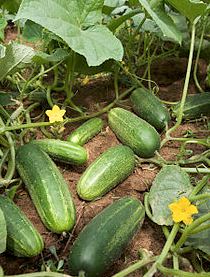Cucumber ( Cucumis sativus )
 The cucumber is a creeping vine that roots in the ground and grows up trellises or other supporting frames, wrapping around supports with thin, spiraling tendrils. The plant has large leaves that form a canopy over the fruit. The fruit of the cucumber is roughly cylindrical, elongated with tapered ends, and may be as large as 60 centimeters (24 in) long and 10 centimeters (3.9 in) in diameter. Having an enclosed seed and developing from a flower, botanically speaking, cucumbers are classified as accessory fruits. Much like tomatoes and squash they are often also perceived, prepared and eaten as vegetables. Cucumbers are usually more than 90% water.
A few cultivars of cucumber are parthenocarpic, the blossoms creating seedless fruit without pollination. Pollination for these cultivars degrades the quality. In the United States, these are usually grown in greenhouses, where bees are excluded. In Europe, they are grown outdoors in some regions, and bees are excluded from these areas.
Most cucumber cultivars, however, are seeded and require pollination. Thousands of hives of honey bees are annually carried to cucumber fields just before bloom for this purpose. Cucumbers may also be pollinated by bumblebees and several other bee species. Most cucumbers that require pollination are self-incompatible, so pollen from a different plant is required to form seeds and fruit.[1] Some self-compatible cultivars exist that are related to the 'Lemon' cultivar.[1] Symptoms of inadequate pollination include fruit abortion and misshapen fruit. Partially pollinated flowers may develop fruit that are green and develop normally near the stem end, but are pale yellow and withered at the blossom end.
Traditional cultivars produce male blossoms first, then female, in about equivalent numbers. Newer gynoecious hybrid cultivars produce almost all female blossoms. They may have a pollenizer cultivar interplanted, and the number of beehives per unit area is increased, but temperature changes induce male flowers even on these plants, which may be sufficient for pollination to occur.[1]
Insecticide applications for insect pests must be done very carefully to avoid killing off the insect pollinators.
The cucumber is a creeping vine that roots in the ground and grows up trellises or other supporting frames, wrapping around supports with thin, spiraling tendrils. The plant has large leaves that form a canopy over the fruit. The fruit of the cucumber is roughly cylindrical, elongated with tapered ends, and may be as large as 60 centimeters (24 in) long and 10 centimeters (3.9 in) in diameter. Having an enclosed seed and developing from a flower, botanically speaking, cucumbers are classified as accessory fruits. Much like tomatoes and squash they are often also perceived, prepared and eaten as vegetables. Cucumbers are usually more than 90% water.
A few cultivars of cucumber are parthenocarpic, the blossoms creating seedless fruit without pollination. Pollination for these cultivars degrades the quality. In the United States, these are usually grown in greenhouses, where bees are excluded. In Europe, they are grown outdoors in some regions, and bees are excluded from these areas.
Most cucumber cultivars, however, are seeded and require pollination. Thousands of hives of honey bees are annually carried to cucumber fields just before bloom for this purpose. Cucumbers may also be pollinated by bumblebees and several other bee species. Most cucumbers that require pollination are self-incompatible, so pollen from a different plant is required to form seeds and fruit.[1] Some self-compatible cultivars exist that are related to the 'Lemon' cultivar.[1] Symptoms of inadequate pollination include fruit abortion and misshapen fruit. Partially pollinated flowers may develop fruit that are green and develop normally near the stem end, but are pale yellow and withered at the blossom end.
Traditional cultivars produce male blossoms first, then female, in about equivalent numbers. Newer gynoecious hybrid cultivars produce almost all female blossoms. They may have a pollenizer cultivar interplanted, and the number of beehives per unit area is increased, but temperature changes induce male flowers even on these plants, which may be sufficient for pollination to occur.[1]
Insecticide applications for insect pests must be done very carefully to avoid killing off the insect pollinators.




